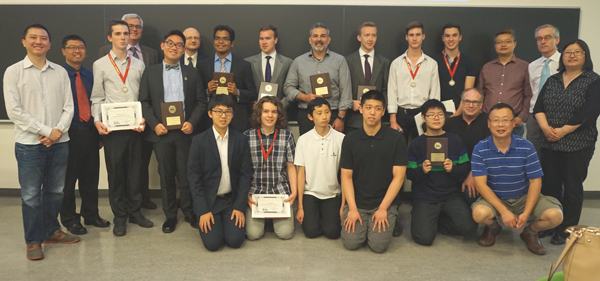The Department of Mathematics & Statistics in the Faculty of Science hosted an awards ceremony for Canada’s first International Mathematical Modeling Challenge (IM2C) for secondary students on June 17.
The evening event brought together students who participated in the 2016 Canadian IM2C, as well as their families and school teachers. It featured two keynote addresses by Matt Davison, professor at Western University and president-elect of the Canadian Applied and Industrial Mathematics Society (CAIMS), and Eric Chuen Cheong, AVP Actuarial Policy at Manulife Financial. Davison provided an overview of how mathematical modelling can be used to replicate or simulate events in the real world—ultimately allowing the “what if” to be answered. Cheong spoke about the importance of math modelling in students’ learning and future careers and provided examples of how math modelling is used in his own industry of insurance. After the speeches, the award winners were announced.

The IM2C is held in various countries annually, but until now Canada has not been a participant. Professors Jianhong Wu, Huaxiong Huang, and Hongmei Zhu from the Department of Mathematics and Statistics, Faculty of Science, as well as Varvara Nika from Toronto Catholic District School Board initiated the first Canadian IM2C in March-April 2016 with funding from CAIMS and EFiC Inc.
The purpose of the IM2C is to promote the teaching and learning of mathematics through contemporary applications and modelling at the high school level. The contest challenges students to apply mathematical tools and concepts to open-ended real world problems, inspiring participants to develop creative problem-solving skills, to engage in productive teamwork and to use effective communication. Participants register as teams of up to four secondary students enrolled in the same school. The teams work for five consecutive days on a modelling problem and submit their solutions to an expert panel for evaluation.
“We felt that it was important to make this opportunity available to Canadian secondary school students to demonstrate their talents and provide them with a deeper experience of how math can be applied and can explain our world,” says Zhu. “And the earlier students can be exposed to the breadth and relevance of math in their lives, the more they will be interested in math when they arrive at colleges and universities.”
The 2016 competition was only available for students in the Greater Toronto Area, but the team is planning to expand the IM2C to all of Ontario and even Canada in the future. The two best papers from the Canadian IM2C (from Senator O’Connor College School and William Lyon Mackenzie Collegiate Institute) were selected by the committee and represented Canada at the international competition. The team from Senator O’Connor College School provided the following testimonial: “What we learned from completing the IM2C competition is that hard work always pays off, no matter the outcome. Even before knowing how we placed, we were all very proud of what we had created. The difficulty of the problem enhanced our teamwork, as we struggled to collaborate efficiently. Overall, the IM2C competition offered the members of our group an enriching experience, and practice for the sort of problems that will arise in the workplace in the future!”
“Our first Canadian IM2C would not have been possible without the help and support of various individuals, including faculty members Ada Chan, Huaxiong Huang, Neal Madras, Jianhong Wu; staff members Ann-Marie Carless, Steven Chen, Susan Rainey; teachers Robert Jordan, Varvara Nika, Hamid Razaghi; and the Office of the Dean in the Faculty of Science,” says Zhu.
For more information about the Canadian IM2C, visit http://im2c-canada.math.yorku.ca/


